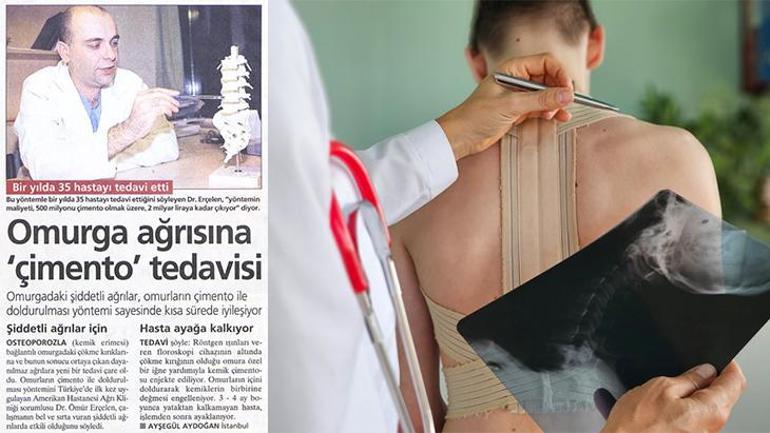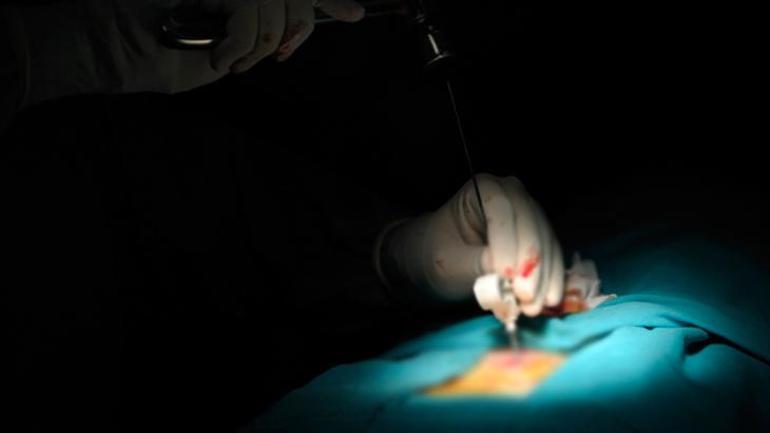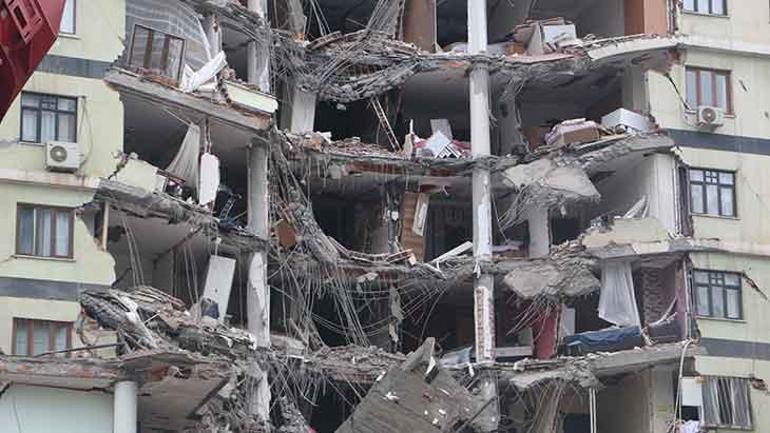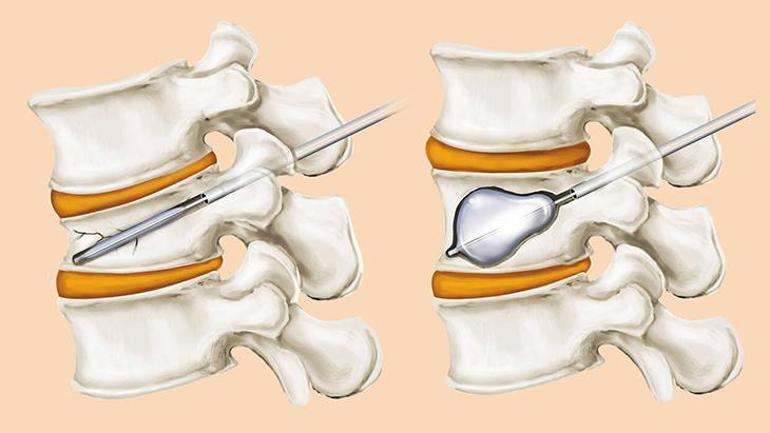It comes into play when it breaks, as in an earthquake! 'Bone made of cement: 'We were the first to do it in Türkiye'

Zeynep Dilara Akyürek / Milliyet.com.tr – Inspired primarily by nature, that is, by what has already been created, Antoni Gaudí built structures that defied the ages. Nature was truly tightly bound to architecture and construction by connections unseen by anyone. The human body, every system of which inspires awe, is one of the most important nodes in this connection. No structure without columns can defy time and earthquakes. Without columns, a building cannot stand. And humans defy time with a 33-ring column that will keep them standing tall and that they will need for the rest of their lives. If you ask what this giant and powerful "column" in the human body is, the answer lies in the spine, which holds up the waist and back, about which many people complain of pain from time to time. The spine consists of 33 bones that protect and sustain the most vital points of our body. However, over time or through accidents and carelessness, it can wear out or become damaged. In this case, the "pain" that many people complain of makes itself felt. Although not every pain has the same cause, Prof. Dr. According to Ömür Erçelen, "sudden stabbing" pain can be treated with "cement" surgery, which has been performed in Turkey since 2002. But where and how do these pains arise? Is concrete used in "cement" surgery? Anesthesiology and Reanimation Specialist Prof. Dr. Ömür Erçelen, a board member of the International Association for the Study of Pain (IASP), the European Society of Anesthesiology (ESA), and the Turkish Association of Anesthesiology and Reanimation, spoke to Milliyet.com.tr about the healing that comes from "cement."

WHAT IS THIS CEMENT? 'IT IS INJECTED BETWEEN THE BONES'
According to a report in Milliyet newspaper on February 13, 2002, an interesting treatment method had begun to be implemented in our country. This treatment was being applied to depressed fractures in the spine using "cement." What do you mean? Was the cement supposed to be applied to the bones? Prof. Dr. Ömür Erçelen, one of the team that would first implement this treatment mentioned in the report 23 years ago, explained what cement actually was. Some things can't be replaced by anything other than themselves. Even if you filled a jar with stones, the voids would remain and wouldn't be completely filled. In other words, while this problem already had a solution before the surgery that brought Prof. Dr. Ömür Erçelen and his team to Turkey, the best treatment for depressed fractures came with "cement made from bone powder." Bone cement was used for this painless treatment, which wouldn't require months of bed rest. Prof. Dr. Ömür Erçelen explained how it was applied :
Spinal fractures can have several causes. The most common cause is osteoporosis, or bone loss. It's often seen in older patients with osteoporosis. A second cause is metastases to the spine in cancer patients. These compression fractures are also seen in traumas like falls and accidents. There used to be no treatment for these. Patients were placed in corsets. These corsets were left in place for at least two months. Patients were given bed rest. What does it mean to confine someone to bed for two months? You increase the risk of clot formation. You increase the risk of lung problems. You increase the likelihood of wounds from being bedridden. In other words, while trying to heal them, you can actually make them sicker. What happened 20 years ago? We have something called bone cement, which is normally used in bone replacement surgery. These prosthetics are placed between the bones to harden and bond. The French invented a system of injecting this material into the spine with special needles. Seeing that this was done abroad 20 years ago, we decided to implement it in Türkiye. "We did. This is a team effort. We were the first team to implement it, and we got very good results."

According to Professor Dr. Erçelen, this method was open to improvement and has continued to be used in a healthy way until today. Physicians from many disciplines used this method for the treatment of depressed fractures. So much so that not only medical researchers but even a mechanical company operating in Silicon Valley developed a revolutionary device to perform this surgery. This device is still used in operations today.
This system has become so advanced that special pumps have been invented for the injection of these cements. A Silicon Valley mechanical company even developed a device that inserts a balloon into the spine, inflates it, and then fills it with cement. They call this 'kyphoplasty.' These methods are now being used in many hospitals throughout Turkey, including all over the world. In other words, all spine specialists—orthopedists, neurosurgeons, spine surgeons, algiologists, and even radiologists—are now using this method with more advanced techniques in all their hospitals in Turkey. Initially, we used biopsy needles used for other purposes. But now, the system has evolved so much that it's become routinely used. – Prof. Dr. Ömür Erçelen

'FOR SPINE FRACTURES SIMILAR TO EARTHQUAKE DEBRIS'
The bones of the spine are crucial, delicate, yet powerful. Of the 33 bones that support your entire body and allow you to stand upright, seven are in the neck. Twelve are in the back, five in the lumbar spine, five are fused in the sacrum, the lowest part of the spine, and four fused bones are located in the coccyx. Discs are located between the vertebrae, providing mobility and shock absorption. This mobile structure and upright posture of the spine are similar to a flexible yet sturdy building that wobbles during an earthquake. Furthermore, there are structures between the bones that connect them, resembling columns. However, compression fractures in these bones can lead to uncomfortable pain and an unhealthy lifestyle. While we may not feel the importance of the bones and muscles there when we're not using our hands, the spine is active even when you're not in motion. Without a spine, many of your bones and muscles wouldn't function properly. Therefore, the spine is one of the most critical parts of the body, and it's the one that many people complain of pain in.
According to Prof. Dr. Ömür Erçelen, vertebrae can fracture in a manner reminiscent of a building collapsing in an earthquake, but they are not unlike broken arm or leg bones. The bone cement surgery, the first of which Prof. Dr. Erçelen and his team performed in Turkey 23 years ago, resembles earthquakes and construction sites due to the similarity in name and the health issue involved. The similarities between nature, construction, and health, and the invisible bond between them, are even more evident here. Prof. Dr. Erçelen explains, "We use bone cement for spinal fractures. Normally, flat bones, such as arm and leg bones, are flat and break in the middle. However, vertebrae are angular and collapse in place. They collapse like buildings in an earthquake."

Completed in 15 to 20 minutes! No pain or discomfort.
Just as every surgery has its advantages and disadvantages, the same applies to the application of bone cement. According to Prof. Dr. Erçelen, when this surgery is performed on a patient with advanced osteoporosis, the area is strengthened, and either the upper or lower vertebrae of the reinforced area are fractured. This is reminiscent of the "hammering effect" observed in adjacent buildings with uneven floors during an earthquake. If the "ceiling or floor" of one of two adjacent buildings is at the same level as the middle of the column of the other, the two buildings will break each other during an earthquake. Prof. Dr. Erçelen explains this as follows:
"Fractures to other bones after this surgery are not caused by our intervention. The operated spot becomes stronger, and this time, fractures begin above or below. Therefore, it's not just about performing this surgery. It's also important to treat the osteoporosis to prevent other bones from breaking as well. Our greatest advantage in this procedure is that by immediately relieving the patient's pain, we prevent the patient from complications related to bed rest. We prevent the possibility of clots in the lungs, the possibility of collapsed lungs, pressure sores due to bed rest, and osteoporosis, which can progress after two months of rest. This method is now in routine use. At our center, this procedure is performed on two to three patients daily. We usually perform it within 15-20 minutes. Initially, it took several hours. You perform this surgery under x-ray. In other words, the radiology techniques of 20 years ago and the current equipment are quite different. They are more modern, emit less radiation, are less risky, and provide a clearer image, allowing us to perform it more quickly. This is our youngest patient we've performed this surgery on." He was 17 or 18 years old. Our oldest patient was in his 90s. We were able to get a patient who came in with dramatic pain to his feet within 1-2 hours of performing this procedure. The patient, who had been unable to get out of bed for 10 days, was able to get up and his pain was gone within two hours of performing this procedure.
So, what are the symptoms of compression fractures? What kind of pain might indicate this problem? Prof. Dr. Erçelen listed the symptoms of compression fractures and concluded his remarks as follows:
"It's important to be careful during exercise or at rest, especially in women over 60 and those who have gone through menopause. Sudden back pain, sudden back pain after a negative movement, heavy lifting, or even coughing should raise suspicion. It's important to consult a specialist if such symptoms are observed."
milliyet





